
James Marshall "Jimi" Hendrix was an American guitarist, songwriter and singer. Although his mainstream career spanned only four years, he is widely regarded as the greatest and one of the most influential electric guitarists in the history of popular music, and one of the most celebrated musicians of the 20th century. The Rock and Roll Hall of Fame describes him as "arguably the greatest instrumentalist in the history of rock music."
Jimmy James and the Blue Flames was a short-lived American rock group that was fronted by Jimi Hendrix, who was then going by the name "Jimmy James". The band was Hendrix's first extended foray into the 1966 Greenwich Village music scene and included future Spirit guitarist Randy California. At various New York clubs, they played a mix of rock, blues, and rhythm and blues songs as well as early versions of songs that became part of the Jimi Hendrix Experience repertoire. It was at such a performance that the Animals' bassist Chas Chandler first heard their rendition of "Hey Joe" and decided to invite Hendrix to England and become his producer.

Electric Ladyland is the third and final studio album by the Jimi Hendrix Experience, released in October 1968. A double album, it was the only record from the Experience with production solely credited to Hendrix. The band's most commercially successful release and its only number one album, it was released by Reprise Records in the United States on October 16, 1968, and by Track Records in the UK nine days later. By mid-November, it had reached number 1 on the Billboard Top LPs chart, spending two weeks there. In the UK it peaked at number 6, where it spent 12 weeks on the British charts.
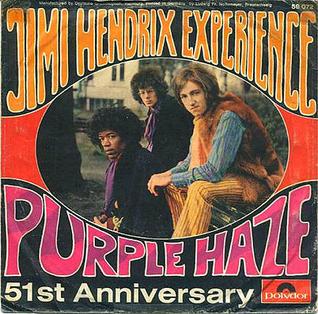
"Purple Haze" is a song written by Jimi Hendrix and released as the second single by the Jimi Hendrix Experience on March 17, 1967, in the United Kingdom. The song features his inventive guitar playing, which uses the signature Hendrix chord and a mix of blues and Eastern modalities, shaped by novel sound processing techniques. Because of ambiguities in the lyrics, listeners often interpret the song as referring to a psychedelic experience, although Hendrix described it as a love song. It was included as the opening track in the North American edition of the Experience's debut album, Are You Experienced (1967).

Axis: Bold as Love is the second studio album by the Jimi Hendrix Experience. It was first released by Track Records in the United Kingdom on December 1, 1967, only seven months after the release of the group's highly successful debut album, Are You Experienced. In the United States, Reprise Records delayed the release until the following month. The album reached the top ten in the album charts in both countries.
"Little Wing" is a song written by Jimi Hendrix and recorded by the Jimi Hendrix Experience in 1967. It is a slower tempo, rhythm and blues-inspired ballad featuring Hendrix's vocal and guitar with recording studio effects accompanied by bass, drums, and glockenspiel. Lyrically, it is one of several of his songs that reference an idealized feminine or guardian angel-like figure. At about two and a half minutes in length, it is one of his most concise and melodically focused pieces.
"Voodoo Chile" is a song written by Jimi Hendrix and recorded in 1968 for the third Jimi Hendrix Experience album Electric Ladyland. It is based on the Muddy Waters blues song "Rollin' Stone", but with original lyrics and music. At 15 minutes, it is Hendrix's longest studio recording and features additional musicians in what has been described as a studio jam.
Curtis Knight, born Mont Curtis McNear, was an American musician who is known for his association with Jimi Hendrix.
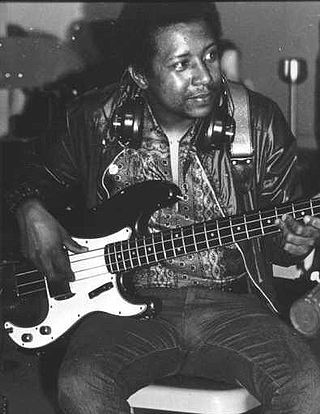
William "Billy" Cox is an American bassist, best known for performing with Jimi Hendrix. Cox is the only surviving musician to have regularly played with Hendrix: first with the experimental group that backed Hendrix at Woodstock, followed by the trio with drummer Buddy Miles that recorded the live Band of Gypsys album, and, lastly, The Cry of Love Tour trio with Mitch Mitchell back on drums. Cox continues to perform dates with the Band of Gypsys Experience and the Experience Hendrix Tour.
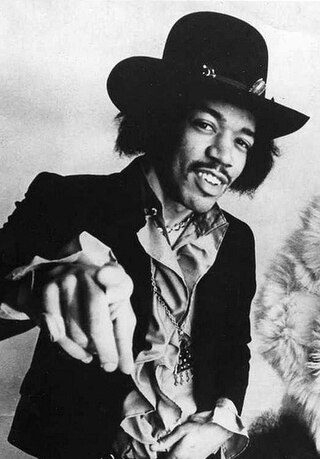
Jimi Hendrix (1942–1970) was an American guitarist whose career spanned from 1962 to 1970. His discography includes the recordings released during his lifetime. Prior to his rise to fame, he recorded 24 singles as a backing guitarist with American R&B artists, such as the Isley Brothers and Little Richard. Beginning in late 1966, he recorded three best-selling studio albums and 13 singles with the Jimi Hendrix Experience. An Experience compilation album and half of a live album recorded at the Monterey Pop Festival were also issued prior to his death. After the breakup of the Experience in mid-1969, songs from his live performances were included on the Woodstock: Music from the Original Soundtrack and More and Band of Gypsys albums. A studio single with the Band of Gypsys was also released.
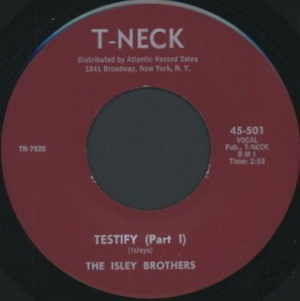
"Testify" is an uptempo soul song by the American rhythm and blues group the Isley Brothers. Written by the Isleys and recorded in 1964, it followed several successful singles by the group and was the first single to appear on their own T-Neck record label.
"Stone Free" is a song written by Jimi Hendrix and the second song recorded by the Jimi Hendrix Experience. It has been described as a "counterculture anthem, with its lyrics praising the footloose and fancy-free life", which reflected Hendrix's restless lifestyle. Instrumentally, the song has a strong rhythmic drive provided by drummer Mitch Mitchell with harmonic support by bassist Noel Redding. "Stone Free" was issued on December 16, 1966, as the B-side of the Experience's first UK single "Hey Joe" and later included on the Smash Hits compilation album.

The Bag O'Nails was a live music club and meeting place for musicians in the 1960s and situated at 9 Kingly Street, Soho, London, England.
"Third Stone from the Sun" is a mostly instrumental composition by American musician Jimi Hendrix. It incorporates several musical approaches, including jazz and psychedelic rock, with brief spoken passages. The title reflects Hendrix's interest in science fiction and is a reference to Earth in its position as the third planet away from the sun in the solar system.
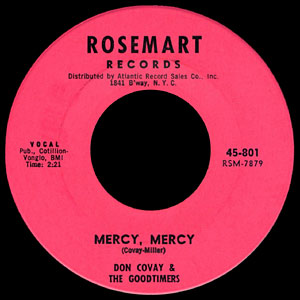
"Mercy, Mercy" is a soul song first recorded by American singer/songwriter Don Covay in 1964. It established Covay's recording career and influenced later vocal and guitar styles. The songwriting is usually credited to Covay and Ron Alonzo Miller, although other co-writers' names have also appeared on various releases.

"Can You Please Crawl Out Your Window?" is a folk rock song written by American musician Bob Dylan. In 1965, Columbia Records released it as a single, which reached number 58 on the US Billboard Hot 100 chart, and number 17 on the UK chart in January 1966. While Dylan never included the song on any of his studio albums, it appears on compilations, such as Biograph and Side Tracks.
The Golden Bear was a nightclub in Huntington Beach, California, from 1923 to 1986. The Golden Bear was located on Pacific Coast Highway, just south of Main Street. It started out as a restaurant, and eventually hosted such artists as Dick Dale, Janis Joplin, Arlo Guthrie, Stevie Ray Vaughan, The Doors, Jackson Browne, Jimi Hendrix, Joan Jett & the Blackhearts, Dave Mason, Tower of Power, The Chambers Brothers, José Feliciano, Hoyt Axton, Bonnie Raitt, Rory Gallagher, Bill Monroe, Steve Martin and Jerry Garcia.

"Hear My Train A Comin'" is a blues-based song written by Jimi Hendrix. Lyrically, it was inspired by earlier American spirituals and blues songs which use a train metaphor to represent salvation. Hendrix recorded the song in live, studio, and impromptu settings several times between 1967 and 1970, but never completed it to his satisfaction.
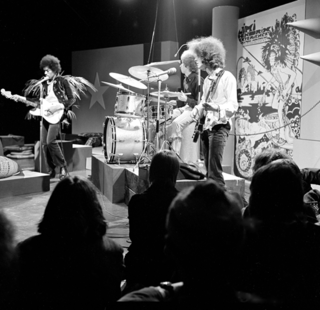
Jimi Hendrix (1942–1970) was an American guitarist and singer-songwriter whose career spanned from 1962 to 1970. He appeared in several commercially released films of concerts and documentaries about his career, including two popular 1960s music festival films – Monterey Pop (1968) and Woodstock (1970). A short documentary, Experience (1968), also known as See My Music Talking, was also screened.
Ed Chalpin was a record executive and producer. He is probably remembered for his association with Curtis Knight and the Squires which caused problems for Jimi Hendrix throughout his career. Chalpin is responsible for the recordings from that period, some of which appear on You Can't Use My Name: The RSVP/PPX Sessions.












